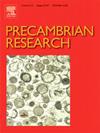Synthesis of structure and tectonic evolution of Meso-Neoproterozoic Vindhyan Basin, India using geophysical and geological data: A plate tectonic perspective
IF 3.2
2区 地球科学
Q2 GEOSCIENCES, MULTIDISCIPLINARY
引用次数: 0
Abstract
The Origin of the Mesoproterozoic intracratonic basins is not well understood compared with the Phanerozoic basins of the world. The present investigation attempts to comprehend the evolution of one such basin of Indian origin and relates its tectonic events with the amalgamation and fragmentation of supercontinents. The Vindhyan basin, India, is one of the largest Meso-Neoproterozoic basins in the world and has probable hydrocarbon potential. It is mostly undeformed and unmetamorphosed, except at the margins. Seismic reflection and refraction, gravity, and well data are integrated with geology, geochemistry, and geochronological data to understand the tectonic evolution of the region. A basement ridge identified in the study divides the basin into two parts: the Chambal valley in NW and Son-valley in SE, which contain 5.8 km and 4.5 km thick Proterozoic sediments. A collisional suture and an arc signature are identified at the Narmada-Son Lineament zone. We suggest a dual-stage foreland basin system has evolved due to the subduction of the leading edge of the Bundelkhand Craton beneath the Mewar and Bastar Cratons around 1.8 Ga. Subsequent collisions of these cratons resulted in the evolution of Aravalli and Satpura orogens. Nature of basin boundary faults, crustal-scale Great Boundary Thrust in NW, and the Narmada-Son lineament in SE, formed during the collision processes are discussed. Far-field plate boundary forces developed due to subduction-collision processes likely influenced the evolution of the basins subsequent to foreland setup. Presence of the Vindhyan Sea and tilting of the continental block to northeast during 1200–800 Ma resulted in common Upper Vindhyan sedimentation in the Chambal- and Son-Valley Basin, including the Ganga Basin in NE. Present study suggests extension of the Vindhyan Basin beneath the Ganga basin. We propose an evolutionary model in a plate tectonic framework that explains several aspects of the basin, including the formation of basin-central ridge during Proterozoic subduction process. The 2.5 Ga and 2.2 Ga events of the region are cotemporaneous with the assembly and breakup of Neoarchean supercontinent Kenorland. Timings of Lower and Upper Vindhyan sedimentation and termination broadly coincide with the assembly and breakup of Paleo- and Mesoproterozoic supercontinents Columbia and Rodinia.

基于地球物理和地质资料的印度中新元古代温德扬盆地构造与构造演化综合:板块构造视角
与世界上显生宙盆地相比,中元古代克拉通内盆地的成因尚不清楚。本研究试图理解这样一个印度盆地的演化,并将其构造事件与超大陆的合并和分裂联系起来。印度Vindhyan盆地是世界上最大的中-新元古代盆地之一,具有潜在的油气资源。除了边缘部分,它大部分没有变形和变形。地震反射和折射、重力和井数据与地质、地球化学和地质年代学数据相结合,以了解该地区的构造演化。研究发现的基底脊将盆地分为两部分:西北的Chambal谷和东南的son谷,分别含有5.8 km和4.5 km厚的元古代沉积物。在Narmada-Son界线带发现了一个碰撞缝合带和一个弧标志。我们认为,在1.8 Ga前后,由于本德尔坎德克拉通的前缘俯冲到Mewar和Bastar克拉通之下,形成了两期前陆盆地体系。这些克拉通随后的碰撞导致了Aravalli造山带和Satpura造山带的演化。讨论了在碰撞过程中形成的盆地边界断裂、NW地壳规模的大边界逆冲和SE的Narmada-Son构造的性质。俯冲碰撞过程形成的远场板块边界力可能影响了前陆构造后盆地的演化。在1200-800 Ma期间,温德扬海的存在和大陆块体向东北的倾斜导致了包括东北恒河盆地在内的昌巴尔-森河谷盆地共同的上温德扬沉积。目前的研究表明,温德扬盆地延伸至恒河盆地之下。我们提出了一个板块构造框架下的演化模型,解释了盆地的几个方面,包括元古代俯冲过程中盆地中心脊的形成。该地区的2.5 Ga和2.2 Ga事件与新太古代超大陆Kenorland的聚集和分裂是同时期的。下、上温海统沉积和终止的时间与古元古代超大陆哥伦比亚和罗迪尼亚的聚集和分裂大致一致。
本文章由计算机程序翻译,如有差异,请以英文原文为准。
求助全文
约1分钟内获得全文
求助全文
来源期刊

Precambrian Research
地学-地球科学综合
CiteScore
7.20
自引率
28.90%
发文量
325
审稿时长
12 months
期刊介绍:
Precambrian Research publishes studies on all aspects of the early stages of the composition, structure and evolution of the Earth and its planetary neighbours. With a focus on process-oriented and comparative studies, it covers, but is not restricted to, subjects such as:
(1) Chemical, biological, biochemical and cosmochemical evolution; the origin of life; the evolution of the oceans and atmosphere; the early fossil record; palaeobiology;
(2) Geochronology and isotope and elemental geochemistry;
(3) Precambrian mineral deposits;
(4) Geophysical aspects of the early Earth and Precambrian terrains;
(5) Nature, formation and evolution of the Precambrian lithosphere and mantle including magmatic, depositional, metamorphic and tectonic processes.
In addition, the editors particularly welcome integrated process-oriented studies that involve a combination of the above fields and comparative studies that demonstrate the effect of Precambrian evolution on Phanerozoic earth system processes.
Regional and localised studies of Precambrian phenomena are considered appropriate only when the detail and quality allow illustration of a wider process, or when significant gaps in basic knowledge of a particular area can be filled.
 求助内容:
求助内容: 应助结果提醒方式:
应助结果提醒方式:


